Sled dogs learn from their “pack” or their team. But they also learn, like us, from their personal experiences.
The Black Team that Allen raced in Iditarod was our “young” team. In total, 8 dogs — or 50% of the team — were rookies to the race. They had never gone 1,000 miles. Therefore, they had no previous personal experiences to guide them this distance. With these youngsters it just takes time and patience. And each dog learns at their own rate.
Many people focus on the “running” part of a race. Yes, this is important. What speed is the team traveling? Or how fast did the team run from checkpoint to checkpoint? But, actually, the “resting” part of the race is more important than the “running”. And with a young dog, the “rest” will often determine the speed of the “run”.
Why is rest so important? A dog, like a human, can grind through a work day whether they had a good night’s sleep or not. How many people go to work on very few hours of sleep? You can ‘power through’ the day, barely keeping your eye lids open. But, when you are tired, you don’t really want to be at work and honestly, it’s simply not as fun or productive! We never want a dog to think “Hey… this isn’t fun!” And in order to actually make it 1,000 miles, a dog needs to be productive.
These photos are taken in Manley, only the second checkpoint of the race. At every checkpoint, the teams are allotted one bale of straw for bedding. Veterans Iditarod dogs love straw. It is cozy, warm, they can roll in it, sleep in it, hide in it… Straw is their signal to rest. And veterans know that resting is important.


(L – R) The Veterans: Beemer and Boondocks snuggle together; Lester has sweet dreams in his straw bed.
Rookie dogs don’t always understand straw. Should they sit on it? Play with it? Pee in it? Eat it? It’s all very confusing. They think “Shouldn’t this straw be in my dog house? Hey… where is my dog house!?”


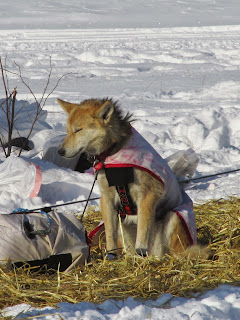
(L – R) The Rookies: Junior plays with the straw as Allen doles it out; Commando sits in his straw and watches birds fly overhead; Chipper embarrasses herself by falling asleep while sitting up.
These guys obviously have a lot to learn! Allen reported that most of the youngsters finally got the hang of resting by mid way through the race. Early on he had to manually lay a few of them into their straw beds for them to sleep. Chipper was the slowest to learn. She didn’t want to go to sleep because “she might miss something exciting!” At the halfway point, in the Huslia checkpoint, Allen said the entire team finally understood: rest means rest. If you look at the team’s rest time at that checkpoint you’ll see that Allen choose to stay several extra hours — simply because they were all sleeping so well. It was an exciting moment for the team!
The experiences that the Black Team members had during the 2015 Iditarod will mold their future as sled dogs. While walking through the SP Kennel yard this Spring, these now Iditarod Veterans look different and act different than only a few short months ago. Each dog processed the Iditarod differently but in the end, they all learned the most important lesson:
I CAN DO ANYTHING!
And better yet… they all want to know: When can I do it again?!?


(L – R) The 2015 Iditarod Start: Bug-eyed Commando and crazed Driver can’t control themselves; Siblings Kodiak and Junior leave the starting chute in lead.

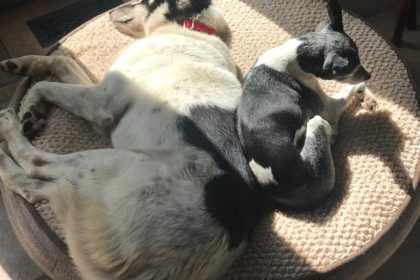



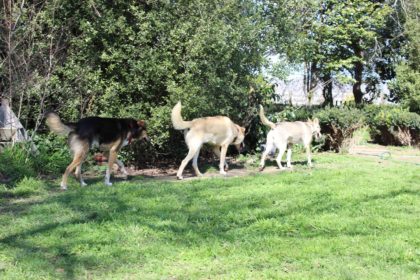
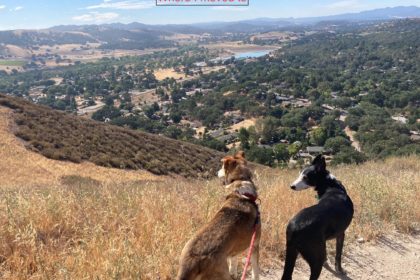
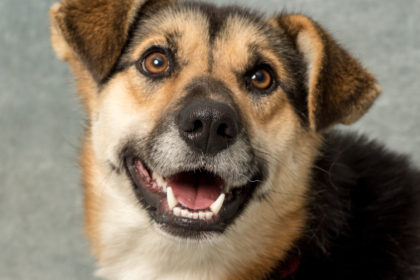
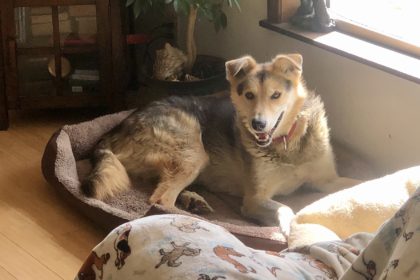
Love this! The pictures are so neat! And the way you explain everything is just so fun to read! Thank you so much, Aliy!
Wonderful post!!! Thanks so much!!!
"Learning" is a function all of us need to be able to do – 2 and 4 legged creatures. Ideally we learn in both a family setting as well as an educational one.
The lucky dogs at SP Kennel have it all – family and extended family cheering them on and giving them the love that brings out their best!
I'm with Chipper!!!
It is too exciting to lie down and go to sleep sometimes!!!
All the best,
–Margaret
P.S. Woof, woof, woof!!!
Thanks!
A nice perspective into the junior racing kids view of the trail. Thanks for sharing.
It was so interesting to me about the straw/doghouse connection and that there might be some confusion as to what to do with the straw…and where's my doghouse. Love the pic of Beemer & Boondocks snuggling in the straw. Veterans doing their job. Thanks for a great post!
Love those pictures of Chipper and Commando. So telling! It's really something how much the dogs must learn to execute the race. Kudos to the youngsters.
Holly
Fascinating. Didn't want that post to end.
Also serves as a reminder to take my own sleep more seriously. I'm a bit of a sleep-fighter like Chipper. That photo of her cracks me up!
I always get a kick out of seeing the veterans taking their rest seriously and being calm at the starting chute…apparently knowing to save precious energy for when they NEED it! It's equally enjoyable to see and hear how the rookies are learning….I'm especially impressed with Commando…bird watching and all!! Thanks for the insightful post!
Yay for the rookies! You go doggies. Who needs to sleep laying down when you can do it sitting up AND not miss anything that's going on? Just like a toddler!
Wonderful insight into the learning process and a peek at how different dogs react. No two are ever exactly alike–right? That's been my experience working with stock dogs and with horses and m mules. Siblings, parents and all the rest–each one is unique. They may have traits in common but none are 'identical twins' and that is what makes it fun and a challenge. Loved this essay and of course the pix!! Thanks for sharing these special glimpses!
Awesome write up!
Chipper was absolutely adorable falling asleep standing up in the video <3
Thank you Allen,
for leaving no sleeping dog behind in Huslia, or those young 'un wouldn't ever dare to sleep again, ha ha.
So much fun to be had on the Iditarod trail with the BIG DOGS!
Margaret's right, we don't sleep much during Iditarod, and we don't want to go to work either Aliy! But, we're not the ones with the sled, thank goodness.
Thanks for another great, informative post & pictures. Chipper is so cute sleeping sitting up. Glad she learned to get her rest. Appreciate the outstanding way you keep us learning more about what happens on the trail & during a race.